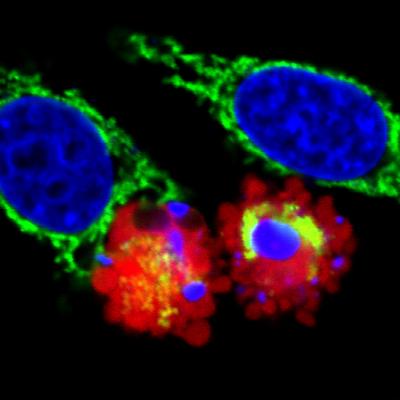Trinity scientists make breakthrough in understanding Parkinson's disease

Parkin-expressing cells (red) are undergoing programmed cell death. Credit: Dr. Emilie Hollville and Professor Seamus Martin, Trinity College Dublin
- The scientists showed that the Parkin protein functions to repair or destroy damaged nerve cells, depending on the degree to which they are damaged
- People living with Parkinson's disease often have a mutated form of the Parkin gene, which may explain why damaged, dysfunctional nerve cells accumulate
Scientists at Trinity College Dublin have made an important breakthrough in our understanding of Parkin – a protein that regulates the repair and replacement of nerve cells within the brain. This breakthrough generates a new perspective on how nerve cells die in Parkinson's disease.
The Trinity research group, led by Smurfit Professor of Medical Genetics, Professor Seamus Martin, has just published its findings in the internationally renowned, peer-reviewed Cell Press journal, Cell Reports.
Although mutation of Parkin has been known to lead to an early onset form of Parkinson's for many years, understanding what it actually did within cells has been difficult to solve.
Now, Professor Martin and colleagues have discovered that in response to specific types of cell damage, Parkin can trigger the self-destruction of 'injured' nerve cells by switching on a controlled process of 'cellular suicide' called apoptosis.
Using cutting-edge research techniques, the Martin laboratory, funded by Science Foundation Ireland, found that damage to mitochondria (which function as 'cellular battery packs') activates the Parkin protein, which results in one of two different outcomes – either self-destruction or a repair mode. Which outcome was chosen depended on the degree of damage suffered by the cellular battery packs.
Importantly, these new findings suggest that one of the problems in Parkinson's disease may be the failure to clear away sick nerve cells with faulty cellular battery packs, to make way for healthy replacements. Instead, sickly and dysfunctional nerve cells may accumulate, which effectively prevents the recruitment of fresh replacements.
Commenting on the findings, Professor Martin stated: “This discovery is surprising and turns on its head the way we thought that Parkin functions. Until now, we have thought of Parkin as a brake on cell death within nerve cells, helping to delay their death. However, our new data suggests the contrary: Parkin may in fact help to weed out injured and sick nerve cells, which probably facilitates their replacement. This suggests that Parkinson's disease could result from the accumulation of defective neurons due to the failure of this cellular weeding process.”
Professor Martin also added: “We are very grateful for the support of Science Foundation Ireland, who funded this research. This work represents an excellent example of how basic research leads to fundamental breakthroughs in our understanding of how diseases arise. Without such knowledge, it would be very difficult to develop new therapies.”
The work was carried out in Trinity's School of Genetics and Microbiology. The research team was led by Professor Martin and included Trinity PhD student Richard Carroll and Research Fellow Dr Emilie Hollville. The Trinity research team is internationally recognised for its work on the regulation of cell death.
For media queries, please contact:
Thomas Deane, Press Officer for the Faculty of Engineering, Mathematics and Science, Trinity College Dublin, at deaneth@tcd.ie or Tel: +353-1-896-4685 / +353-85-131-5587
Smurfit Professor of Medical Genetics, Seamus Martin, Trinity College Dublin, at martinsj@tcd.ie
Notes to the editor:
1. Full title of the journal article is: 'Parkin Sensitizes toward Apoptosis Induced by Mitochondrial Depolarization through Promoting Degradation of Mcl-1, Cell Press journal, Cell Reports
About Trinity College Dublin
Trinity College Dublin, founded in 1592 is Ireland's oldest university and today has a vibrant community of 17,000 students. It is recognised internationally as Ireland's premier university. Cutting edge research, technology and innovation places the university at the forefront of higher education in Ireland and globally. It encompasses all major academic disciplines, and is committed to world-class teaching and research across the range of disciplines in the arts, humanities, engineering, science, social and health sciences.
Trinity is Ireland's leading university across all international rankings, and was ranked 61st globally in 2013 QS World University Ranking http://www.tcd.ie .
High-resolution images and captions are available, and can be accessed from this Dropbox folder: https://www.dropbox.com/sh/cyd6sf5eazbqsr0/AAB7uFMeI9-CbxVbJ4L7L3Cfa?dl=0
Media Contact
All latest news from the category: Life Sciences and Chemistry
Articles and reports from the Life Sciences and chemistry area deal with applied and basic research into modern biology, chemistry and human medicine.
Valuable information can be found on a range of life sciences fields including bacteriology, biochemistry, bionics, bioinformatics, biophysics, biotechnology, genetics, geobotany, human biology, marine biology, microbiology, molecular biology, cellular biology, zoology, bioinorganic chemistry, microchemistry and environmental chemistry.
Newest articles

Combatting disruptive ‘noise’ in quantum communication
In a significant milestone for quantum communication technology, an experiment has demonstrated how networks can be leveraged to combat disruptive ‘noise’ in quantum communications. The international effort led by researchers…

Stretchable quantum dot display
Intrinsically stretchable quantum dot-based light-emitting diodes achieved record-breaking performance. A team of South Korean scientists led by Professor KIM Dae-Hyeong of the Center for Nanoparticle Research within the Institute for…

Internet can achieve quantum speed with light saved as sound
Researchers at the University of Copenhagen’s Niels Bohr Institute have developed a new way to create quantum memory: A small drum can store data sent with light in its sonic…





















